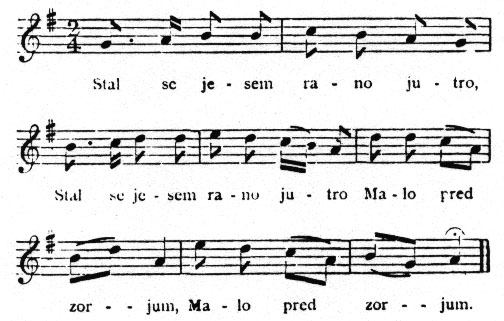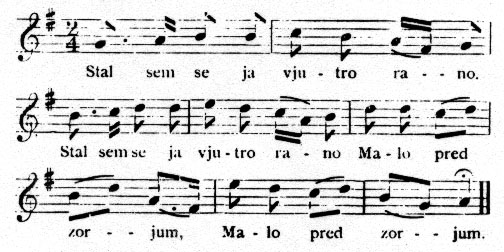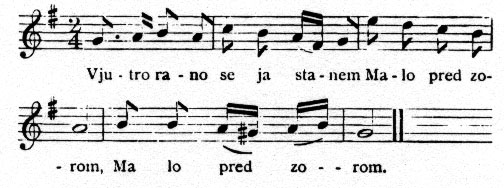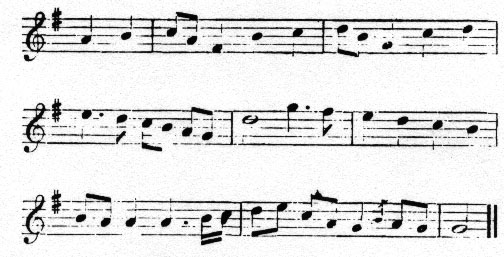A CROATIAN COMPOSER
NOTES TOWARD THE STUDY
OF
JOSEPH HAYDN
First edition in 1897, London,
reprinted in 1972, New York.
Joseph Haydn (1738-1809). Pencil sketch by
George Dance, 1794.
Source of the photo Classical
Music Pages.
[GERMAN NATIONAL ANTHEM and its relation to a Croatian folk song]
EXCERPTS from the book from p. 65 to p. 72.
p. 65 (a) [related to German National Anthem] The song "Stal se jesem," as sung in Marija Bistric-

[Stal se jesem rano jutro, Stal se jesem rano jutro Malo pred zorjum, Malo pred zorjum.]
* The musical stanza, in this song, goes to a half-stanza of the words. The first is-
Stal se jesem rano jutro
i.e.
In the early morning stood I
Malo pred zorjom
Close upon the dawn.
(b) The same song as it appears in the district of S. Ivan Zeline-

[Stal se jesem rano jutro. Stal se jesem rano jutro Malo pred zorjum, Malo pred zorjum.]
(c) The same as it appears at Medjumur (Murinsel)-

[Stal sem se ja vjutro rano. Stal sem se ja vjutro rano Malo pred zorjum, Malo pred zorjum.]
In these versions the last four bars appear to have been loosely attached to the rest of tune; at any rate, they are often found, apart from the first phrase, in Croatian carols and drinking songs.
p. 67 Variant from Kolnov (near Oedenburg)-

[Vjutro rano se ja stanem Malo pred zorom, Malo pred zorom.]
(e) Variant from Cembe-

[Vjutro rano se ja stanem Malo pred zorom; Vjutro rano se ja stanem malo pred zorom.]
The rest is easily divined. When in 1797 Haydn was commissioned to set the National Anthem, he must have had this tune before his eye, and have determined to use it as the pedestal of the Monumentum aere perennius which his loyalty erected. And here a word may be said as to the manner in which the great tune appears to have been written. It was no momentary inspiration, no sudden impromptu that should come into existence at full growth; like most of Beethoven's music, it was made carefully, and by deliberate weighing of alternatives. By a piece of singular good fortune, we are for once admitted to the master's workshop, and allowed to take our lesson in melody by the observation of his practice.
Now the second strain of the folk-tune is too short to fit the second line of the poem; accordingly, Haydn began by extending its cadence, and instead of -

wrote

following it with repeat-marks, after the common method of primary form. Two other changes explain themselves. The measure is dignified by the broader time-signature, and the accent shifted from arsis to thesis by the rearrangement of the bars. Otherwise, in the first half of the stanza the folk-tune remains unaltered.
But for the second half it was manifestly insufficient. Both the possible variants are too trivial, and one too brief, to afford the requisite climax. As a natural consequence, Haydn discarded both, and proceeded to supply their place with two original strains, which in the Autograph sketch run as follows: -

Still, he was dissatisfied with the result, and it is easy to suggest the reason. I the former of these two strains there is a passage which carries tonic harmony - out of place at this stage of the tune - and its cadence, moreover, rhymes awkwardly with that of the half-stanza. The latter of the two comes down from its point of stress with a fine sweeping movement, but, three bars from the end, breaks its melodic curve into two distinct pieces, and so loses continuity of line. Both were accorindly corrected, one on the same page, the bottom stave of which bears, in hasty manuscript, the amended form-

the other, with a few more minute alterations, at a later period of work. And thus, of such diverse metal as Cellini cast his "Perseus," did Haydn beat out the melody by which he has given voice to a nation's patriotism.
Back to Sir W.H. Hadow: A Croatian Composer; notes towards the study of Joseph Haydn
